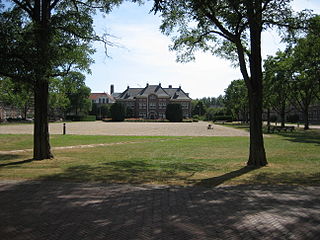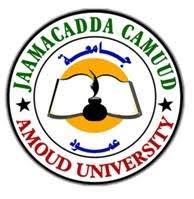Related Research Articles

Postgraduate education, graduate education, or graduate school consists of academic or professional degrees, certificates, diplomas, or other qualifications usually pursued by post-secondary students who have earned an undergraduate (bachelor's) degree.
An academic degree is a qualification awarded to a student upon successful completion of a course of study in higher education, usually at a college or university. These institutions often offer degrees at various levels, usually divided into undergraduate and postgraduate degrees. The most common undergraduate degree is the bachelor's degree, although some educational systems offer lower-level undergraduate degrees such as associate and foundation degrees. Common postgraduate degrees include engineer's degrees, master's degrees and doctorates.

A master's degree is a postgraduate academic degree awarded by universities or colleges upon completion of a course of study demonstrating mastery or a high-order overview of a specific field of study or area of professional practice. A master's degree normally requires previous study at the bachelor's level, either as a separate degree or as part of an integrated course. Within the area studied, master's graduates are expected to possess advanced knowledge of a specialized body of theoretical and applied topics; high order skills in analysis, critical evaluation, or professional application; and the ability to solve complex problems and think rigorously and independently.
A bachelor's degree or baccalaureate is an undergraduate degree awarded by colleges and universities upon completion of a course of study lasting three to six years. The two most common bachelor's degrees are the Bachelor of Arts (BA) and the Bachelor of Science. In some institutions and educational systems, certain bachelor's degrees can only be taken as graduate or postgraduate educations after a first degree has been completed, although more commonly the successful completion of a bachelor's degree is a prerequisite for further courses such as a master's or a doctorate.

The Bologna Process is a series of ministerial meetings and agreements between European countries to ensure comparability in the standards and quality of higher-education qualifications. The process has created the European Higher Education Area under the Lisbon Recognition Convention. It is named after the University of Bologna, where the Bologna declaration was signed by education ministers from 29 European countries in 1999. The process was opened to other countries in the European Cultural Convention of the Council of Europe, and government meetings have been held in Prague (2001), Berlin (2003), Bergen (2005), London (2007), Leuven (2009), Budapest-Vienna (2010), Bucharest (2012), Yerevan (2015), Paris (2018), and Rome (2020).

Education in France is organized in a highly centralized manner, with many subdivisions. It is divided into the three stages of primary education, secondary education, and higher education. Two year olds do not start primary school, they start preschool. Then, by the age of six, a child in France starts primary school and soon moves onto higher and higher grade levels until they graduate.

The British undergraduate degree classification system is a grading structure used for undergraduate degrees or bachelor's degrees and integrated master's degrees in the United Kingdom. The system has been applied, sometimes with significant variation, in other countries and regions.
A graduate diploma is generally a qualification taken after completion of a first degree, although the level of study varies in different countries from being at the same level as the final year of a bachelor's degree to being at a level between a master's degree and a doctorate. In some countries the graduate diploma and postgraduate diploma are synonymous, while in others the postgraduate diploma is a higher qualification.

Bright Futures is a scholarship program in the state of Florida. It is funded by the Florida Lottery and was first started in 1997.

University College Utrecht (UCU) provides English-language Liberal Arts and Sciences undergraduate education. Founded in 1998, as the first university college in the Netherlands, it is part of Utrecht University. Around 750 students of 70 different nationalities live and study on campus. Students can design their individual curriculum with courses in one of the three departments: Science, Social Sciences and Humanities.
Honours degree has various meanings in the context of different degrees and education systems. Most commonly it refers to a variant of the undergraduate bachelor's degree containing a larger volume of material or a higher standard of study, or both, rather than an "ordinary", "general" or "pass" bachelor's degree. Honours degrees are sometimes indicated by "Hons" after the degree abbreviation, with various punctuation according to local custom, e.g. "BA (Hons)", "B.A., Hons", etc. In Canada, honours degrees may be indicated with an "H" preceding the degree abbreviation, e.g. "HBA" for Honours Bachelor of Arts or Honours Business Administration.
A dean's list is an academic award, or distinction, used to recognize the highest level scholarship demonstrated by students in a college or university. This system is most often used in North America, though institutions in Europe, Asia, and Australia may also employ similar measures. It is often synonymous with honor roll and honor list, but should not be confused with honours degrees.
The Carnegie Unit and the Student Hour are strictly time-based references for measuring educational attainment used by American universities and colleges; the Carnegie Unit assesses secondary school attainment, and the Student Hour, derived from the Carnegie Unit, assesses collegiate attainment.
Credit Accumulation and Transfer Scheme (CATS) is used by many universities in the United Kingdom to monitor, record and reward passage through a modular degree course and to facilitate movement between courses and institutions. One UK credit is equivalent to the learning outcomes of 10 notional hours of study, thus a university course of 150 notional study hours is worth 15 credits, and a university course of 300 notional study hours is worth 30 credits. A full academic year is worth 120 credits and a full calendar year 180 credits. CATS schemes in use in Higher Education in the UK include CATS, SCOTCAT (Scotland), the Credit and Qualifications Framework for Wales credit framework (Wales), the Learning and Skills Development Agency credit framework and Open College Network credits.

Amoud University is a comprehensive public university, located in the city of Borama in Somaliland.

An academic certificate or tech certificate is a document that certifies that a person has received specific education or has passed a test or series of tests.
A super-senior is a student in a four-year educational institution who has more than four years in attendance or a surplus of credits required for a diploma and has not yet graduated. In certain cases these students are also known as postgraduates.
There are four grading systems in Greece – four different GPA – one for higher education, one for secondary education, and two for primary education.

Kilis 7 Aralık University is located in the city of Kilis, in southeastern Turkey. The name of the university comes from the date when the city of Kilis was liberated from occupation during the Turkish War of Independence – December 7, 1921.

Pyramids Higher Institute for Engineering and Technology (PHI) is an Egyptian private higher institute in 6th of October City, Giza Governorate. Established in 2007 by Engineer Mohamed Hamdy Zaki by Ministerial Resolution No. (2591) of the same year in accordance with Law No. 52 of 1970. The institute specializes in the study of engineering and is considered one of the leading higher institutes locally. It is divided into five departments covering the most important engineering fields required in the labor market at the local and international levels. The institute is affiliated with Al Baraka Society for Social and Educational Services.
References
- ↑ "Digest of Education Statistics, 2015". nces.ed.gov. Retrieved 12 September 2017.
- ↑ "European Credit Transfer and Accumulation System (ECTS)". European Education Area. European Union. Retrieved 23 August 2023.
- ↑ "Course components". University of Sydney: Current students. University of Sydney . Retrieved 14 March 2022.
- ↑ "What is Equivalent Full-Time Student Load (EFTSL)?". AskQUT. Queensland University of Technology . Retrieved 14 March 2022.
- ↑ "Glossary of university terms". University of South Australia: Student life. University of South Australia . Retrieved 14 March 2022.
- ↑ "What is a credit point?". Griffith University: Ask us: Current student. Griffith University . Retrieved 14 March 2022.
- ↑ "Study loads for Austudy and Youth Allowance". Services Australia. Services Australia (Australian Government agency). Retrieved 14 March 2022.
- ↑ "Ordenanza de estudios de grado y otros programas de formation terciario". Universidad de la República. 30 August 2011. Retrieved 4 February 2016.
- ↑ "NIT Trichy - System of Evaluation". www.nitt.edu. Retrieved 2021-03-31.
- ↑ "Osmania University's UG syllabus all set for major revamp". Telangana Today.
- ↑ "Universities set to introduce choice-based credit system | Patna News - Times of India". The Times of India.
- ↑ "UGC seeks info on CBCS implementation, curriculum revision". April 14, 2018.
- ↑ "What is Credit? A guide for students" (PDF). Quality Assurance Agency for Higher Education. 21 September 2021.
- ↑ Dianna L. Van Blerkom (7 January 2011). College Study Skills: Becoming a Strategic Learner. Cengage Learning. ISBN 978-0-495-91351-1 . Retrieved 3 December 2012.
- ↑ 34 CFR 668.8 (l)
- ↑ "2 Program Eligibility, Written Arrangements, and Distance Education". Federal Student Aid Handbook. Vol. 2.
- ↑ "Structure of the U.S. Education System: Credit Systems". US Department of Education. Feb 2008
- ↑ "Pages - Academic - Secondary". www.yrdsb.ca. Retrieved 2018-12-08.
- ↑ "Credit and Qualifications Framework for Wales". Business Wales. Retrieved 23 August 2023.
- ↑ "About the framework". Scottish Credit and Qualifications Framework. Retrieved 23 August 2023.
- ↑ "Section E - Design and development of qualifications". Ofqual Handbook: General Conditions of Recognition. Condition E8 - Credit. Retrieved 23 August 2023.